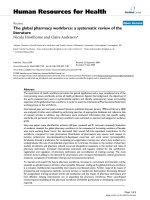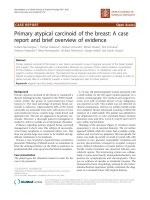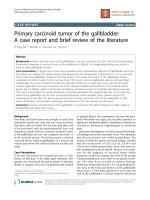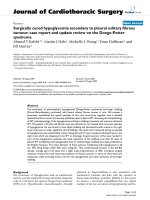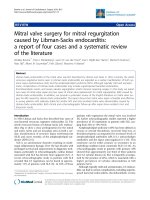Imperforate anus with rectopenile fistula: A case report and systematic review of the literature
Bạn đang xem bản rút gọn của tài liệu. Xem và tải ngay bản đầy đủ của tài liệu tại đây (935.59 KB, 6 trang )
Yang et al. BMC Pediatrics (2016) 16:65
DOI 10.1186/s12887-016-0604-z
RESEARCH ARTICLE
Open Access
Imperforate anus with rectopenile fistula: a
case report and systematic review of the
literature
Gang Yang1, Yingli Wang2 and Xiaoping Jiang1*
Abstract
Background: Although anorectal malformations (ARMs) are frequently encountered, rare variants difficult to classify
have been reported.
Methods: This study describes a patient with ARM and rectopenile fistula. The literature was reviewed systematically to
assess the anatomical characteristics, clinical presentations and operations of this rare type of ARM.
Results: Eight patients were reported in the six included articles. In three patients, the fistula extended from the
rectum to the anterior urethra without communication with the skin. In one patient, the fistula, located deep in corpus
spongiosum, opened to the ventral aspect of the penis without communication with the urethra. In the remaining four
patients, the fistula extended from the rectum to the cutaneous orifice in the ventral aspect of penis, with
communication or a short common channel with the urethra.
Conclusions: Imperforate anus with fistula extending into the penis is a rare variant of anorectal malformation.
Unawareness of this lesion resulted in a delay of correct diagnosis and appropriate management. A thorough
examination, including colonourethrography and fistulography, should be performed in all patients with a fistula
opening in the ventral aspect of the penis.
Keywords: Anorectal malformation, Rectopenile fistula, Systematic review
Background
Anorectal malformations (ARMs) are frequently encountered anomalies of diverse types. Most types of ARMs
can be determined by a thorough perineal inspection or
colostogram. Some rare variants, however, may be difficult to classify. This report describes a rare form of
ARM with a fistula opening in the ventral aspect of the
penis and communicating with the urethra. The literature was reviewed systematically to assess the anatomical
characteristics, clinical presentations and operations of
this rare type of ARM. Understanding of this lesion is
critical for early diagnosis and appropriate treatment.
* Correspondence:
1
Department of Pediatric Surgery, West China Hospital, Sichuan University,
Chengdu 610041, People’s Republic of China
Full list of author information is available at the end of the article
Case report
A 4-h-old male newborn weighing 3,400 g was referred
to our hospital with an imperforate anus. There was no
orifice in the perineal region. A white median raphe cyst,
4 mm in diameter, was present on the ventral side of the
penis. Auscultation of the heart and lungs was normal.
The patient’s family history was unremarkable. After 24
h, the color of the middle raphe cyst turned dark green.
The cyst was incised at bedside, and meconium passed
from it. Insertion of a soft catheter showed a deep fistula
running parallel to the urethra (Fig. 1a). Urination was
normal, with no urine passed from the fistula. Urethrography and fistulography, performed 3 and 4 days after
birth, respectively, showed a long fistula running parallel
to the urethra from the rectal pouch to the penis
(Fig. 1b). The distance between the rectal pouch and the
anal dimple was 1 cm. During urethrography, a small
amount of contrast retrograde had flowed into the rectal
pouch (Fig. 2a), suggesting a communication between
© 2016 Yang et al. Open Access This article is distributed under the terms of the Creative Commons Attribution 4.0
International License ( which permits unrestricted use, distribution, and
reproduction in any medium, provided you give appropriate credit to the original author(s) and the source, provide a link to
the Creative Commons license, and indicate if changes were made. The Creative Commons Public Domain Dedication waiver
( applies to the data made available in this article, unless otherwise stated.
Yang et al. BMC Pediatrics (2016) 16:65
Page 2 of 6
Fig. 1 a A catheter was inserted into the orifice of the fistula. b Fistulography showed the fistula and the end of the rectum
the fistula and the urethra. X-rays and ultrasound did
not show any anomalies in the sacrum and spinal cord.
No other anomalies could be identified.
One-stage limited posterior sagittal anorectoplasty
(PSARP) was performed on the fourth day after birth.
With the urethral catheter indwelling, the patient was
placed in the prone position, and a sagittal incision was
made. The posterior rectal wall was opened in the midline and extended distally, ending directly at the fistula,
which was 2 mm in diameter. The dissection continued
between the rectum and the urethra until the two structures were completely separated from each other. The
distal end of the fistula was ligated to the remaining part
of the corpus spongiosum penis (Fig. 2b). The muscles
were repaired and anorectoplasty was performed. The
urethral catheter was removed on the seventh postoperative day and there was no difficulty in urination. Patient
recovery was uneventful and he was discharged on the
eighth postoperative day. Follow-up for eight months
has shown no evidence of secretion passing from the
opening of penile fistula, and the patient has been doing
well. Bowel control could not be evaluated owing to patient age.
Methods
The systematic review of patients with imperforated
anus and rectopenile fistula adhered to PRISMA guidelines. PubMed and EMBASE (from January 1989) were
systematically searched for relevant articles published in
English through November, 2014, using as search terms:
(anorectal malformation OR imperforate anus) AND
(penis fistula). The titles and abstracts of all potential
relevant articles were read to determine their relevance.
Full articles were also scrutinized if the title and abstract
were unclear. Reference lists of identified articles were
screened for additional publications of interest.
Studies were included if they assessed patients with
ARM having fistulas extending from the rectal pouch to
Fig. 2 a Urethrography showed the urethra and the bladder. A small amount of contrast appeared in the rectum. The location of fistula entering
the urethra was displayed (arrow). b Limited PSARP was performed. The rectum had been divided (upper arrow) and a catheter was inserted to
the fistula (lower arrow)
Yang et al. BMC Pediatrics (2016) 16:65
the penis deep in the spongy urethra, with or without
connections to the urethra. Studies were also included if
they described treatment details and showed radiographic images. Only studies published in English were
included. Review articles and editorials were excluded.
All identified articles were independently assessed by
two authors. Detailed data regarding study design, patient characteristics, initial diagnoses, radiological diagnoses, symptoms, and treatment were extracted into an
electronic data sheet in a standardized manner.
Results
Of the 52 papers identified by searching the databases,
four met the study criteria and were included [1–4].
No reports were repetitive. Two additional articles
were identified by manual searching [5, 6]. The 48 papers excluded were review articles, irrelevant to the
current study or published in a language other than
English (Fig. 3). Table 1 shows the details of the included articles.
The six included articles described a total of eight patients. In all eight, the ends of the rectum were below
the ischial line. In three patients, the fistulas extended
from the rectum to the anterior urethra without communicating with the skin. In one patient, the fistula,
Fig. 3 PRISMA flow chart of literature search
Page 3 of 6
located deep in the corpus spongiosum, opened to the
ventral aspect of the penis without communicating with
the urethra. In the other four patients, the fistulas extended from the rectum to the cutaneous orifices on the
ventral aspect of the penis, communicating with or sharing a short common channel with the urethra. Each of
the eight patients underwent two to four operations. Although having a low type of ARM, seven patients underwent colostomy owing to the puzzling courses of the
fistulas. Anoplasty was completed by perineal operations
in six patients, an anterior sagittal approach in one and
a posterior sagittal approach in one. In two patients, the
fistulas were not removed because they did not communicate with the urethra. Five of these eight patients had
other anomalies, including congenital heart disease, bifid
scrotum, solitary kidney, hypospadias, undescended
testis and hydronephrosis.
Discussion
ARM with fistula deep in the spongy urethra, with or
without communication with the urethra, is a rare
anomaly [7]. The nine patients reported to date can be
classified into three groups (Fig. 4). The first group consists of patients with an imperforate anus and a fistula
running parallel to the urethra, extending from the
Authors
Year Age of
Diagnosis
Type of Fistula
Level of rectum
(distance to skin)
Operation
Management of fistula
Associated anomalies
Complications
Ohno et al.
2008 6 months
parallel to the urethra
from the rectal pouch
to the spongy urethra
Below the ischium
(1 cm)
Transverse colostomy,
ASARP, colostomy
clousure
Severed from the
rectum and ligated
Right aortic arch
Vesicoureteral reflux,
constipation
Kumar et al.
2005 18 months between the anal canal
and the skin in the
peno-scrotal junction,
with a small portion of
common channel in the
penile urethra
Anoplasty, colostomy +
fistula excision
removed
Shah et al.
2003 9 months
From the rectum to the low
ventral aspect of the
penis, no communication
with urethra
Transverse colostomy,
PSARP, colostomy closure
Ligated, distal part
was kept undisturbed
Currarino et al.
1994 9 months
extending from rectum
to cutaneous orifice
near the penoscrotal
junction, with
communication with the
bulbar urethra
Below the ischial line
Perineal anoplasty, descending
colostomy, fistula excision
Bifid scrotum, mild sacral
anomalies
A long rectocutaneous
fistula open on the
undersurface of the
penis, communicating
with the bulbar urethra
Below the ischial line
Colostomy, sacroperineal
rectal pull-through with
ligation of rectal fistula,
colostomy closure, excision
of urethrocutaneous fistula
Bifid scrotum
below the I line
Sigmoid colostomy, perineal
anoplasty and revision of
the fistula
Bifida scrotum, hypospadias,
right undescended testicle,
right hydronephrosis,
congenital heart disease
2 days
Takamatsu et al. 1993 11 months Fistula between the
anorectum and anterior
urethra
Asano et al.
Unknown
Fistula between the
anorectum and anterior
urethra
Below the I line
Sigmoid colostomy, revision
of fistula and perineal
anoplasty
1983 3 months
Fistula from rectum and
open in the ventral
surface of the penis,
communication with
urethra
Under the skin
Cutback procedure, excision
of the fistula
Solitary kidney
Urinary tract infection
Page 4 of 6
ASARP: anterior sagittal anorectoplasty; PSARP: posterior sagittal anorectoplasty
Yang et al. BMC Pediatrics (2016) 16:65
Table 1 Summary of included cases
Yang et al. BMC Pediatrics (2016) 16:65
Page 5 of 6
Fig. 4 Diagrams for the different type of malformations (a anopenile urethral fistula; b fistula extending in the corpus spongiosum and opening
in the ventral aspect of the penis; c Fistula with a communication or a short common channel with the urethra)
rectal pouch to the anterior urethra, a condition defined
as anopenile urethral fistula. The second group consists
of patients with an imperforate anus and a fistula extending to the corpus spongiosum and opening in the
ventral aspect of the penis. The third group consists of
patients with an imperforate anus and a fistula passing
distally within the corpus spongiosum and ending in the
ventral aspect of the penis, with a communication or a
short common channel with the urethra.
The embryology of these anomalies has not been determined. One study reported that this condition was a
variant of anorectal malformation with a deep rectocutaneous fistula that may partially fuse with the urethra
[6]. The patient described in this report could be classified into the third group. A filiform fistula must have
been present between the rectal pouch and the urethra,
because the contrast retrograde flowed into the rectal
pouch during urethrography.
Determination of anatomy is important in the management of ARM. Thorough perineal inspection may provide important clues about the anatomical type [8].
Median raphe cysts usually occur in low-type anorectal
malformations and suggest the location of the fistula [9].
In our patient, a probe tube was inserted into the fistula
after incision of the median raphe cysts. A fistula was
observed deep within the urethra cavernosum, excluding the possibility of a perineal fistula. Urethrography
and fistulography with water soluble contrast radiography were important in delineating the fistula in all
eight patients.
Anorectoplasty in patients with “low type” malformation can be completed through a perineal, anterior sagittal or limited posterior sagittal approach [10]. Bowel
control was excellent in most reported cases. Diverting
colostomy may be unnecessary, providing that the anatomical structure is understood and delineated before
surgery. Colostomy, however, is prudent if there is any
suspicion about the anatomy. Fistula management
should be individualized, with no uniform recommendations made. The origin of the fistula from the rectum
must be ligated. The distal part of the fistula may be
kept undisturbed or removed based on its relationship
with the urethra, the estimated risk of infection and the
difficulty of the procedure.
Conclusions
Imperforate anus with the fistula extending into the corpus spongiosum is rare, but good prognosis can be
achieved by appropriate treatment. However, lack of
awareness of these lesions may delay a correct diagnosis,
putting patients at risk of multiple operations. Therefore,
patients with a fistula opening in the ventral aspect of
the penis should be thoroughly examined, including by
colonourethrography and fistulography, to clarify their
anatomy before surgery.
Consent
Written informed consent was obtained from the patient’s parents for publication of this Case report and
any accompanying images. A copy of the written consent is available for review by the Editor-in-Chief of
this journal.
Ethical statement
This study was approved by the Ethics Committee of
West China Hospital.
Availability of data and materials
Not applicable.
Competing interest
The authors declare that they have no competing interest.
Authors’ contributions
YG contributed to the drafting of the manuscript, acquisition of data and
analyzing the data. WYL contributed to performing the database searching
and evaluation of the included articles. JXP contributed to designing of the
study, interpretation the data and final approval of the version to be
published. All authors have read and approved the final manuscript.
Acknowledgements
The authors sincerely thank the patient and his parents for providing all of
the clinical information.
Author details
1
Department of Pediatric Surgery, West China Hospital, Sichuan University,
Chengdu 610041, People’s Republic of China. 2Department of Hematology,
West China Hospital, Sichuan University, Chengdu 610041, People’s Republic
of China.
Yang et al. BMC Pediatrics (2016) 16:65
Page 6 of 6
Received: 11 January 2015 Accepted: 11 May 2016
References
1. Ohno K, Nakamura T, Azuma T, Yoshida T, Yamada H, Hayashi H, Masahata
K. Anopenile urethral fistula. Pediatr Surg Int. 2008;24:487–9.
2. Kumar V, Rao PL, Vepakomma D. Low anorectal malformation associated
with ‘ano-urethro-cutaneous’ fistula. Pediatr Surg Int. 2005;21:829–30.
3. Shah AA, Shah AV. Imperforate anus with rectopenile fistula. Pediatr Surg
Int. 2003;19:559–61.
4. Asano S, Kitatani H, Konuma K. A newborn with a covered anus complicated
by two concomitant unique fistulas. Z Kinderchir. 1983;38:258–61.
5. Takamatsu H, Noguchi H, Tahara H, Kajiya H, Kaji T, Ikee T, Yoshioka T,
Akiyama H. Ano-urethral fistula, a special type of anomaly: report of two
cases. Surg Today. 1993;23:1116–8.
6. Currarino G. Imperforate anus associated with a recto-bulbar-cutaneous
fistula. J Pediatr Surg. 1994;29:102–5.
7. Endo M, Hayashi A, Ishihara M, Maie M, Nagasaki A, Nishi T, Saeki M.
Analysis of 1,992 patients with anorectal malformations over the past two
decades in Japan. Steering Committee of Japanese Study Group of
Anorectal Anomalies. J Pediatr Surg. 1999;34:435–41.
8. Bischoff A, Levitt MA, Peña A. Update on the management of anorectal
malformations. Pediatr Surg Int. 2013;29:899–904.
9. Soyer T, Karabulut AA, Boybeyi Ö, Günal YD. Scrotal pearl is not always a
sign of anorectal malformation: median raphe cyst. Turk J Pediatr. 2013;55:
665–6.
10. Kuijper CF, Aronson DC. Anterior or posterior sagittal anorectoplasty
without colostomy for low-type anorectal malformation: how to get a
better outcome? J Pediatr Surg. 2010;45:1505–8.
Submit your next manuscript to BioMed Central
and we will help you at every step:
• We accept pre-submission inquiries
• Our selector tool helps you to find the most relevant journal
• We provide round the clock customer support
• Convenient online submission
• Thorough peer review
• Inclusion in PubMed and all major indexing services
• Maximum visibility for your research
Submit your manuscript at
www.biomedcentral.com/submit

